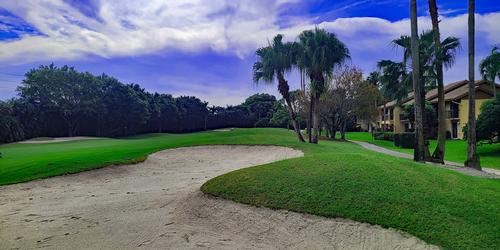
Disney's Magnolia Golf Course
Come Feel the Magic
By David Theoret
Disney's Magnolia Golf Course is a Joe Lee design and sits on a sprawling 175 acres in the heart of Disney, and shares a clubhouse with its sister course The Palm. The pros play this course from the back tees at a length of 7516 yards, making it one of the longest courses on the PGA Tour. From back here, the course carries a course rating of 76.0 with a slope of 141. The Magnolia features five sets of tees, four of which measure over 6,000 yards and is certified by Audubon International as a Cooperative Wildlife Sanctuary. It's also rated 4 stars by Golf Digest and is operated by Arnold Palmer Golf Management.
The Magnolia hosted a PGA Tour from 1971 - 2012 and from all accounts, it was a favorite of the pros. The course gets its name from the over 1500 magnolia trees that grace the property and bloom spectacularly from late spring until mid-summer. But it's not just the flora, it's the fauna as well. It's not unusual to see wild turkeys, deer, osprey, alligators and turtles.
In addition to its affiliation with the PGA Tour, other accolades bestowed upon this venue: include playing host to the PGA Tour Qualifying School finals until the early 1980s. The course also hosted the Bryant Gumbel/Walt Disney World Celebrity Tournament benefiting the United Negro College Fund from 1988 to 1990. In 1995, it became home to the AJGA / Polo Golf Junior Classic and has hosted the ACC Conference Championship.
You'll find a number of elevated tees and greens as well as wide and generous fairways. This might give you the idea you can score well on the Magnolia course, however the water that comes into play on 11 holes as well as the 97 bunkers will have a say about in how well you do.
Memorable Holes (All yardage is from the white tees, 6,558 yards)
Number 1: Par 4, 409 yards. A long slight dogleg left starts off your round on the Magnolia course. Depending on your choice of tee boxes, the bunker on the right side can easily come into play off the tee as can the trees on the left. The green is elevated and surrounded by sand. Walk off with a par and be happy.
Number 6: Par 3, 168 yards. Of the 97 or so bunkers on the course, none is more famous in Florida than the "Mouse Trap". The bunker is shaped like the silhouette of Orlando's favorite rodent and playing out of it is definitely NOT the "Happiest Place on Turf." The hole plays over water from an elevated tee to an elevated green. Be prepared for a slight slowdown here as newcomers to the course usually stop to take a lot of pictures.
Number 8: Par 5, 534 yards. Number 8 could be considered a double dogleg in that it makes two turns to the left. Four bunkers on the left and trees on the right make for a fairly tight landing area off the tee, so finding the fairway can be a little tricky. More bunkers on both sides come into play on your layup shot as the fairway tightens once again. Your approach shot doesn't get any easier as this elevated green is fronted by a large deep bunker with two more flanking the sides. It will take three good shots to do well on this hole.
Number 17: Par 4, 399 yards. The first of two long finishing holes; for the pros, numbers 17 and 18 play 485 and 492 yards respectively; and neither is the longest par 4. That honor belongs to number 9 at 500 yards (for the pros). From the white tees, number 17 plays 399 yards and features water running down the left side as well as a creek on the right. If a draw is in your shot repertoire, now is a good time to use it. A good line is the middle bunker on the right. A successful tee shot of this type will leave an easier approach shot to another elevated green.
Number 18: Par 4, 455 yards. Most golfers have probably played par 5s that are shorter than the finishing hole on the Magnolia course. Trees line both sides of the fairway and it's a straight hole with a well-protected, elevated green. Depending upon your length off the tee, you may want to consider laying up on your second shot and then putting your approach close enough for a one-putt. It's still a four on the scorecard.
Last Word: Choosing the right set of tees is important on the Magnolia course and will go a long way in determining how much you will enjoy your round. There are two sets of tees that play over 7,000 yards, although the "Classic" (pro) tees aren't usually offered as an option. Although it's nice to play where the pros play, but for the sake of the people behind you, please don't bite off more than you can chew. The white tees at 6,558 yards will give most players all they can handle.
Accuracy off the tees is imperative if you want to score well. You will most likely be faced with some long approach shots so being able to hit long irons and hybrids is beneficial as well. The greens are always in immaculate condition and roll a little bit faster than most resort courses. Sand traps are manicure as is the grass at the edge of the water hazards, so don't expect errant shots to be stopped by shoddy grounds work!
Spectator mounds were added in 1993 and come into play should you stray from the fairway leaving the dreaded uneven lie. In the event you're not playing well, just take in the surroundings, especially in early summer. The magnolia trees, crape myrtles and oleanders are in bloom and are simply breathtaking as is the wildlife such as deer, ospreys and wild turkeys.
If you can only play one Disney course, this should be the one. It's both challenging and fair: what you see is what you get. Be sure to take a look at The Wall of Champions in the clubhouse; it may give you some inspiration. For more information on this or any of the Disney courses, visit their website at www.golfwdw.com.
Revised: 10/18/2014 - Article Viewed 30,552 Times
- View Course Profile
About: David Theoret
 David Theoret has been in the golf and golf travel industry for over 10 years, primarily selling online advertising. For the past seven years, he has also been a golf writer, reviewing golf courses, resorts, destinations, equipment, golf apparel, and training aids - the latter of which never seems to help. David's articles and reviews have been posted on many golf travel and equipment websites.
David Theoret has been in the golf and golf travel industry for over 10 years, primarily selling online advertising. For the past seven years, he has also been a golf writer, reviewing golf courses, resorts, destinations, equipment, golf apparel, and training aids - the latter of which never seems to help. David's articles and reviews have been posted on many golf travel and equipment websites.
Growing up in Southwestern Ontario, Canada, it was naturally assumed he would play hockey. Beginning at the age of 3 and continuing into his late 30's, he did just that. However, after one too many pucks to the head, he realized that golf was a lot easier on the body (whoever said hockey players were slow) and took the game up.
After moving to Florida and accepting a position with TravelGolf Media (now part of GolfNow) his love for the game grew exponentially. Most Saturdays you will find him on a course somewhere in Florida or on the practice range reinforcing his bad habits. David plays to a 10 handicap - unless there is money involved in which case it goes considerably higher. He currently resides in Lakeland, FL with his wife Belinda and their two "kids", Madyson and Molly.
Follow David Theoret:
Contact David Theoret:
GolfTrips.com - Contributor
















